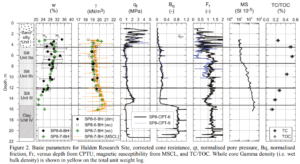04 Jun Geotek Exhibiting at the First International Symposium on GeoTest Sites (ISGTS)
The Norwegian Geotechnical Institute (NGI) is hosting the First International Symposium on GeoTest Sites (ISGTS) on 12-14th June 2019, in Oslo, Norway. The ISGTS aims to present detailed characterisation of a range of natural soils used for benchmarking in geotechnical engineering, as well as promote and increase the use of the benchmark sites as a research tool. During ISGTS, over 30 papers from all around the world will discuss the detailed characterisation determined from the data acquisition at the sites, which will be featured in a special issue of AIMS Geosciences. Geotek will be attending the event as a sponsor, discussing how the MSCL helped to produce detailed characterisation data on four out of the five test sites that are part of the Norwegian GeoTest Sites (NGTS) project.

NGI MSCL-S
NGTS is led by NGI, Norway’s leading geotechnical specialist community and hub for research and consultancy in engineering geosciences on an international level. The test sites carefully placed around Norway representing five specific soil types; sand, silt, soft clay, quick clay and permafrost, allow for the development and trials of new, alternative methods for site investigations and test procedures for the geotechnical engineering community.
Across the soft clay, quick clay, silt, sand and permafrost test-sites, the Geotek Multi-Sensor Core Logger (MSCL-S) logged samples from four of the five test sites. The non-destructive data from the MSCL-S can enable an assessment of core disturbance, and natural sedimentological structure and stratigraphy. More importantly, the data can identify areas of good quality samples for advanced laboratory testing, thus preventing expensive testing programmes of poor quality samples being run.

MSCL log with Magnetic Susceptibility and Gamma density for Halden
Approximately 20m of core at each of the four test sites were logged through the MSCL, collecting measurements of the total unit weight (bulk density/gamma density), magnetic susceptibility and an indirect estimation of the water content. The measurements where done both on whole cores and split cores using the standard MSCL-S core logger from Geotek at 0.5cm resolution. During the project, NGI aimed to link the geological history of the soil deposit and how this impacts the geotechnical properties of the soil. NGI’s geotechnical engineer Priscilla Paniagua explains “subtle changes in soil density and magnetic susceptibility provide valuable information for our work. The high resolution of the MSCL data give the opportunity to study these subtle changes in soil properties over the whole core length, something which is not possible with standard in situ techniques.”
Throughout the NGTS project, the MSCL-S has been a reliable tool for comparing its results to direct measurements for estimating total unit weight (bulk density), water content and magnetic susceptibility, and has achieved the aim of understanding geological history, deposition history and changes in engineering properties at the respective sites.
The data generated at the NGTS test sites will be accessible to enhance and progress geotechnical and foundation engineering methods. For the next 20 years the NGTS will remain operational, offering plenty of possibilities for full-scale tests, sampling and advance testing with new technologies, equipment and techniques to be explored.
For more information about the First International Symposium on GeoTest Sites click here, or if you would like to set up a meeting with our sales representative, please contact sales@geotek.co.uk.
Reference: Blaker Ø, Carroll R., L’Heureux J.S., Klug, M. (2016). Characterisation of Halden silt. Geotechnical and Geophysical Site Characterisation 5, Lehane, Acosta-Martínez & Kelly (Eds). Australian Geomechanics Society, Sydney, Australia.

